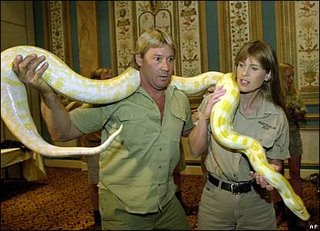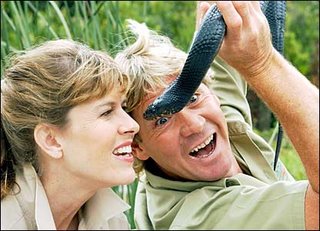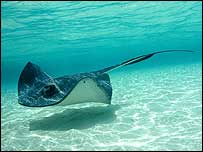









First all I would like to admit that I haven't been watching Crocodile Hunter for the longest time. I can only name work (puke) and Eddy as my excuse. Having said that, I will go on to mention that I am still very much a fan of Steve Irwin. The event that happened on 4th September 2006 has very much affected me. Steve Irwin has been a great inspiration to me. Not just for being the world's original wildlife warrior, but also as a great father and husband.
I was awfully shocked when Eddy told me that night that "what a beauty" had passed away. Crikey! I have watched the man who has played with crocodillys and poked around for venomous snakes to learn that he had finally succumbed to fate from a bull stingray's barb. How ironic is that? He was famous for handling dangerous creatures such as crocodiles, snakes and spiders, and his documentaries on his work with crocodiles drew a worldwide audience of almost 200 million viewers.
I personally feel short changed. I probably will feel differently if it had been a crocodile that had mauled him or a Black Mumba that had bitten him, but now, it's equivalent to being attacked by a hamster judging that stingrays don't usually kill people, unlike my public enemy, le shark. However it is very unfair for me to say all these because this was a freak accident and could have happened to ANYONE, it's just very unfortunate that it had to be Steve Irwin. I'll be wearing a safari suit as a tribute to him on my company's dinner and dance.The theme is to go as your favourite star and he's my favourite star.
STINGRAY FACTS
Sources: Encyclopedia Britannica, Georgia Aquarium, infoplease.com, Surf Life Saving Queensland
I think now the docile stingrays will have a place up in the 'Deadliest Creatures' list!
I don't have the habit of practicing 'diving'', but ever since watching Crocodile Hunter, I have assumed the role of being a 'beetle diver'. You know those miniscule bronze coloured beetles that make 'tok tok tok' sounds when they fly and hit celings and always end up on their backs when they land? (I wonder where they attend flying schools cos they suck at landings) I also recognised the need for rugby players to 'dive' land when they touchdown and goalkeepers to 'dive' to save the ball/ puck or some other solid flying objects.
So far, the most educational and entertaining documentaries are animal doucmentries. It has evolved from being a boring narrated series hosted by elegant old men, to being almost an extreme sport! Just look at Animal Planet! Dig Jeff Corwin and Steve Irwin to name a few. They don't just educate us, they shock us with their antics and provide such entertainment that we enjoy watching animals sleep and eat and hump. Moreover, the hosting position have no longer been dominated by eloquent old men with accents, beautiful women like Linda Lydall have also braved dangers and dirt to conserve animals. Watching animal documentries has provided viewers with much eye candy now.
I love these conservationists.
By the way, stop killing the stingrays.
I was awfully shocked when Eddy told me that night that "what a beauty" had passed away. Crikey! I have watched the man who has played with crocodillys and poked around for venomous snakes to learn that he had finally succumbed to fate from a bull stingray's barb. How ironic is that? He was famous for handling dangerous creatures such as crocodiles, snakes and spiders, and his documentaries on his work with crocodiles drew a worldwide audience of almost 200 million viewers.
I personally feel short changed. I probably will feel differently if it had been a crocodile that had mauled him or a Black Mumba that had bitten him, but now, it's equivalent to being attacked by a hamster judging that stingrays don't usually kill people, unlike my public enemy, le shark. However it is very unfair for me to say all these because this was a freak accident and could have happened to ANYONE, it's just very unfortunate that it had to be Steve Irwin. I'll be wearing a safari suit as a tribute to him on my company's dinner and dance.The theme is to go as your favourite star and he's my favourite star.
STINGRAY FACTS

- Marine fish related to the shark
- Wingspan in different species ranges from 10 inches to 7 feet
- Barb can be up to 12 inches
- Lie buried in sand, and normally very shy and non-aggressive
- Eat worms, mollusks and other invertebrates
- Possess flexible tails armed, in most species, with saw-edged, venomous spines
- Uses barb in self-defense when startled, threatened or cornered; venom causes excruciating pain, and serrated barb damages tissue when pulled out; large rays can exert enough force to drive their tail spines into a wooden boat
- Most stings occur in shallow, coastal waters when swimmers step on a stingray
- Fatal stings extremely rare, with only 17 recorded stingray deaths in Australia since 1969
- Shuffle feet in sand to scare stingrays away
- If stung, soak affected area in extremely hot water to destroy venom
- Seek medical attention immediately
Sources: Encyclopedia Britannica, Georgia Aquarium, infoplease.com, Surf Life Saving Queensland
I think now the docile stingrays will have a place up in the 'Deadliest Creatures' list!
I don't have the habit of practicing 'diving'', but ever since watching Crocodile Hunter, I have assumed the role of being a 'beetle diver'. You know those miniscule bronze coloured beetles that make 'tok tok tok' sounds when they fly and hit celings and always end up on their backs when they land? (I wonder where they attend flying schools cos they suck at landings) I also recognised the need for rugby players to 'dive' land when they touchdown and goalkeepers to 'dive' to save the ball/ puck or some other solid flying objects.
So far, the most educational and entertaining documentaries are animal doucmentries. It has evolved from being a boring narrated series hosted by elegant old men, to being almost an extreme sport! Just look at Animal Planet! Dig Jeff Corwin and Steve Irwin to name a few. They don't just educate us, they shock us with their antics and provide such entertainment that we enjoy watching animals sleep and eat and hump. Moreover, the hosting position have no longer been dominated by eloquent old men with accents, beautiful women like Linda Lydall have also braved dangers and dirt to conserve animals. Watching animal documentries has provided viewers with much eye candy now.
I love these conservationists.
By the way, stop killing the stingrays.
No comments:
Post a Comment